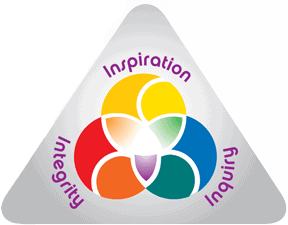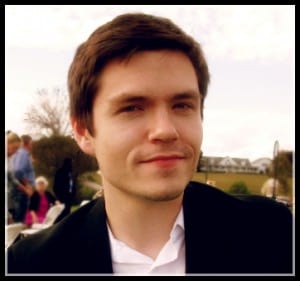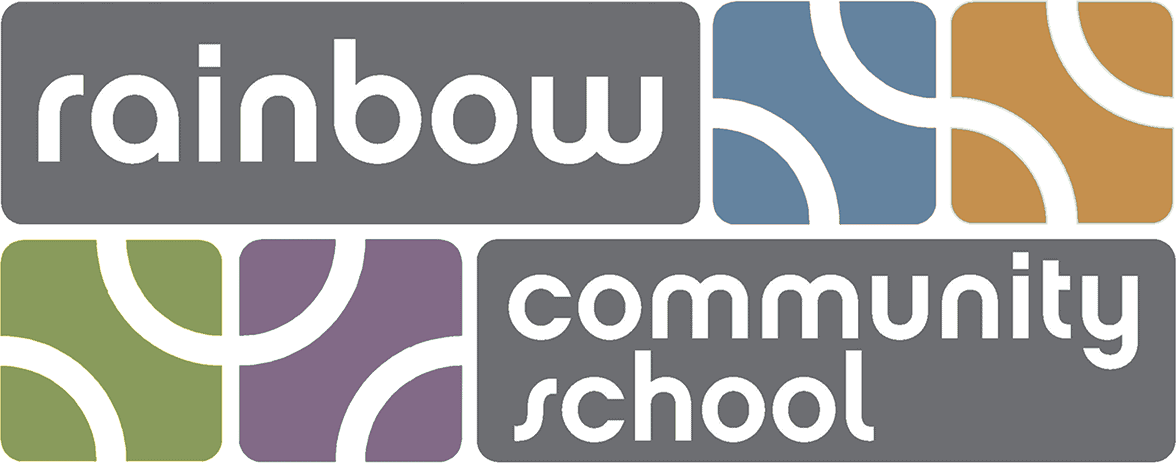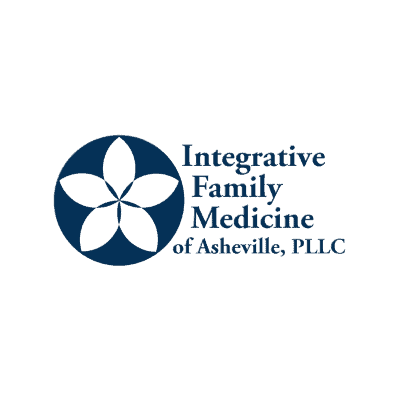
by Renee Owen | Sep 12, 2014 | Director's Blog
How Can a School Promote a Culture of Innovation?
As I enter the “Omega” (7th and 8th grade) classroom at Rainbow Community School, a large Buckminster Fuller-designed dymaxion world map is on the floor, the basis for a game where students are moving around chips that represent various world resources.
Incorporating Systems Thinking
Two students with laptops are meeting with Jason Cannoncro, one of the lead teachers, about a grant proposal they are writing to create a local non-profit organization that will give homeless people work on the many organic farms in Asheville. Several students are puzzling over models they are creating of sustainable energy systems. One girl is playing a radio powered by a tiny solar panel system she designed herself.
How Can We Design Systems to Ensure All Humans Have Their Needs Met?
The curriculum at Rainbow Community School has been carefully designed and refined to prepare students for the culminating middle school unit described above.The essential problem that students ask and begin to solve in that unit is,
“How can we design our systems and our culture to ensure that all humans on Earth have their needs met, without depleting planetary resources?”
The Native Americans thought of sustainability in terms of seven generations. They might have asked the essential question for the unit in this format: “How can we provide dignity for each human and all living beings for the next seven generations?”In this unit students are asked to think about human equity and fulfillment, and how to get there. They are required to develop designs and prototypes for inventions that help sustain the natural world, while providing for a high quality of living. Students who are successful within this multi-faceted, complex unit are the next generation of innovators. How does Rainbow Community School prepare its students for this culminating unit?
You can find out how RCS prepares its students and more on part IV here.
RCS Director, Renee Owen has a series of Educating the Innovation Generation articles.
Click below to see the other parts:
Educating the Innovation Generation – Part I
Educating the Innovation Generation – Part II
Educating the Innovation Generation – Part III

by Webmaster | Jul 24, 2014 | Alumni News & Accolades

Nick Romanos, Rainbow alum
My Rainbow Experience:
Nick came to the Omega program after having completed public elementary school in 2000. During his tenure at Rainbow, he formed lifelong friendships and learned skills that have continued to serve him as he’s progressed in his education and into his adult life.
The best example of this would be the experiential learning that was reenforced with projects and ensuing presentations that he learned at Rainbow.
The school gives students enough space to cultivate creativity with enough personal attention to each student to ensure each one’s musings and explorations are not without focus.
Now, in business, he is constantly having to research all his clients’ industries and present possible solutions to communicate and grow their brand.
Education After Rainbow
Like quite a few Rainbow alumni, Nick finished his K-12 education at Asheville High School.
There he developed an interest in design in their graphic communications program. Along with fellow Rainbow alum, Sam Brubaker, he applied for and was accepted into the NC State University College of Design and begin there in 2007.
What Nick is Doing Now
After graduating, Nick accepted his first career job position at Robin Easter Design doing graphic and web design in Knoxville, TN.
He and his partner Tiana moved to Raleigh, NC after three years to be closer to family, where they knew their hearts belonged.
He had already been networking with Laurel Scherer of Asheville Web Fix. As it turns out, she wanted a web designer. Laurel, Nick, as well as project manager, Jim McClure, transformed the organization into what is now Status Forward – a full-service graphic and web design company. They do everything from websites to broader branding efforts.
Nick has been able to do this work from Raleigh and frequents Asheville for business development meetings. In addition, the company continues to move forward: they are constantly challenged by new subject matter as well as having many clients with diverse needs.
Still Connected to Rainbow
Lastly, Nick was in awe of the nostalgia and good feelings that came from meeting his former science/math and fitness mentor at Rainbow, Mark Hanf. He was in downtown Asheville after having worked a day on-site.
Mark brought him up to speed on his teaching geometry through structure building and hands-on learning. Nick remembers the incredibly talented instructors that he learned from at Rainbow.

by Webmaster | Jul 17, 2014 | Student News & Accolades
With its holistic learning environment, and our research-based methods to elicit creative and critical thinking, many wonderful families have become part of the Rainbow family.
New this year to the school is Duncan, a rising second grader. His younger brother Raleigh will attend the Rainbow Community School Pre-school beginning in November when he turns three years of age.
Duncan’s family is relocating here from Ireland.
Along the way, however, they’re making a few stops. They have traveled to Dublin, Amsterdam, London, and Los Angeles. They will make one more stop in the historic Washington, D.C. just before settling in Asheville and beginning the school year.
We look forward to Duncan sharing his experiences with his classmates as he begins second grade. In fact, his experiences will add a lovely flavor to our global initiatives program!
We’re also very excited that Raleigh will be joining our community in November, too.
Welcome to our family!

Duncan, a rising 2nd grader, in Amsterdam.

Duncan and Raleigh in front of the British Museum
by Renee Owen | Apr 1, 2014 | Director's Blog
Why create innovators?
Rainbow’s mission statement ends by saying we are developing students who will be “leaders in building a more compassionate and environmentally sustainable world.”
Anyone enrolling their child at Rainbow must resonate with the urgency of this goal. One would have to have blinders on to ignore the stream of evidence and quotes from leading scientists, sociologists and experts in almost every field who declare that sustainability is the most important vision for human survival.
From Tony Wagner, “The solution to our economic and social challenges is the same: creating a viable and sustainable economy that creates good jobs without polluting the planet. And there is general agreement as to what that new economy must be based on. One word: innovation.”
This is a three-part Heart of the Matter on preparing children to be innovators. In the first part, we will explore how rapidly our world is changing and try to adjust our own thinking to the new paradigm of innovation. In Part Two we will examine why innovation is important and how innovators are developed. Finally, in Part Three we will unveil the barriers to innovation in our current traditional school system and society. We will understand the methods Rainbow uses to encourage innovation, and how parents can support that effort at home.
Download the rest of Part I here
Innovation Generation Part II

by Renee Owen | Apr 28, 2011 | Director's Blog
There were over 20 people from Rainbow Mountain Children’s School at the Sir Ken Robinson lecture last night, and we were all inspired — actually, validated, is a better word for it. Validated to know that the style of education we have been doing for 34 years at Rainbow, is now considered visionary, cutting edge, and the direction education needs to go nationally.
One of Sir Ken’s points that really stuck with me was when he answered a question by saying, “It’s about Spirit.” He clarified that he was referring to energy. Great teachers are energized by the children and by the material they are teaching. It resonates with their spirit. They also recognize what is special about each child, and they use that. For example, a child who habitually hums would be given more singing instruction and asked to lead songs for the class.
When asked to describe the perfect school, he might as well have been describing Rainbow: A school with strong underlying structure (as Ken said “creativity can only happen within structure”) and an ability to allow both kids and teachers to be creative in all subjects.
Here is another great Sir Ken Robinson talk:












